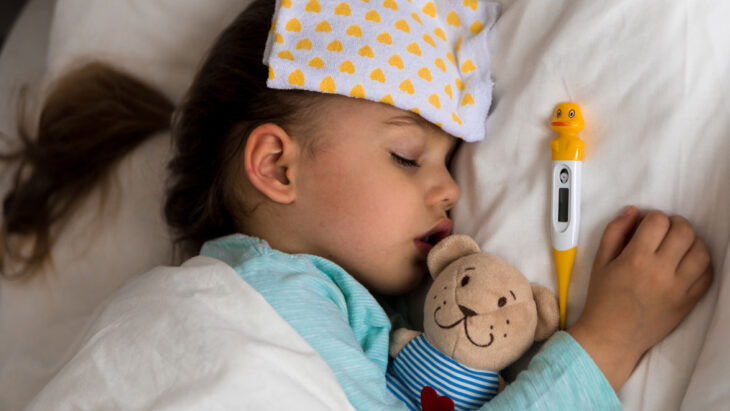From KidMed Pediatric Urgent Care
As a mom, you have powerful instincts. But when your child wakes up coughing at midnight or spikes a fever on a Saturday afternoon, it can be tough to know what to do next. Will the problem pass with fluids and rest? Is it time for a trip to urgent care, or should you head straight to the emergency room?
To help you decide, we’ve gathered a few simple signs that it’s time to pack the diaper bag and go — plus guidance on when it’s okay to wait it out at home. Knowing the difference between what’s urgent and what’s an emergency can save you time, reduce stress and ensure your child gets the right care in the right place.
FEVER THAT JUST WON’T QUIT
Go to urgent care: For babies over 3 months old, many common illnesses can be treated safely in a pediatric urgent care, including ear infections, congestion and mild gastrointestinal symptoms. For older kids, if the fever is over 102 degrees and doesn’t come down with medicine or lasts more than three days, it’s time to be seen.
Go to the ER: If your child is under 3 months old and has a fever of 100.4°F or higher, this should be evaluated in the emergency room.
Wait it out: If it’s a mild fever (99–101 degrees) and your child is otherwise acting normal and drinking fluids, monitor at home and keep him or her comfy.
TROUBLE BREATHING
Go to urgent care: Wheezing, rapid breathing or struggling to catch a breath needs immediate attention. These could be signs of asthma, RSV or a serious respiratory infection. Coughs, colds, asthma symptoms and croup-like symptoms typically can be addressed at a pediatric urgent care.
Go to the ER: You need the ER if your child has severe difficulty breathing or shortness of breath, especially if paired with blue lips or fingernails.
Wait it out: Mild coughs and sniffles without labored breathing often can be treated with rest, hydration and a humidifier.
PERSISTENT VOMITING OR DIARRHEA
Go to urgent care: If your child can’t keep any liquids down, is showing signs of dehydration, or vomiting lasts more than 24 hours, it’s time to go.
Go to the ER: If your baby has no tears when crying and fewer than three wet diapers in a 12-hour period or fewer than six in a 24-hour period, going straight to the ER is best.
Wait it out: A one-time bout of vomiting or loose stool with no other symptoms usually doesn’t require medical attention. Offer small sips of electrolyte drinks and keep an eye on the child.
AN INJURY THAT LOOKS “OFF”
Go to urgent care: If your child falls and can’t put weight on a limb, has swelling or bruising that gets worse or you suspect a sprain or minor fracture, urgent care often can do X-rays and provide immediate care. A pediatric urgent care is equipped to handle most minor cuts, scrapes and burns, as well as evaluate joint pain and possible fractures or breaks.
Go to the ER: If your child has a suspected broken bone with a visible deformity or bone protrusion, head directly to the ER.
Wait it out: A small bump, scrape or mild twist that doesn’t affect movement or improves with ice usually can be treated at home.
STRANGE OR SUDDEN BEHAVIOR
Go to urgent care: If your normally chatty child is suddenly very drowsy, disoriented, irritable or says something like, “It hurts, but I don’t know where,” it’s better to play it safe and get checked out.
Go to the ER: If your child is experiencing any suicidal thoughts or self-harming behavior, you should go to the ER immediately. Seizures, loss of consciousness, unresponsiveness, sudden vision loss or slurred speech also can be best handled in the ER setting.
Wait It out: If the child is just a little off because he or she is tired, teething or fighting a minor bug, you’ll probably see improvement with a nap, snuggles or a quiet day at home.
HERE ARE A FEW OTHER ILLNESSES OR INJURIES THAT CAN BE ADDRESSED AT A PEDIATRIC URGENT CARE:
- Rashes, bug/animal bites, or allergic reactions
- Pink eye, styes, corneal abrasions or other eye irritation
- Urinary tract or bladder symptoms and infections
- Minor head injuries (with no loss of consciousness)
- Ear infections
- Foreign-object removals
- Sports physicals
- On-site lab testing for flu, strep, RSV, mono and Covid-19
- Urinalysis and bacterial cultures
When in doubt, trust your gut — and don’t hesitate to call your local pediatric urgent care or child’s pediatrician for advice. Nothing gives peace of mind like knowing you’re doing the right thing — for your child and yourself.
KidMed Pediatric Urgent Care, located in Gulfport, offers pediatric health care services seven days a week without the need for an appointment. Contact KIDMED at (228) 240-8833.


